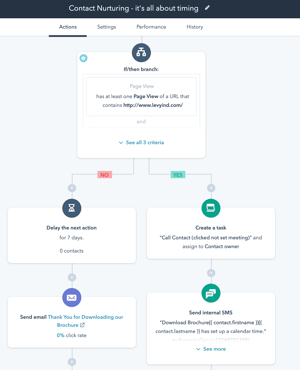What is Marketing Automation?
Marketing automation is a business process that uses online software platforms and related technologies to assist marketers with automating processes throughout the sales cycle, or buyer’s journey as it’s increasingly called these days. Marketing automation software can reduce time and effort by eliminating repetitive tasks.
Marketing automation software can function among multiple online tactics or channels that include development of segmented lists, campaign management, blog publishing, social media posts, outbound emails, receiving client follow-up alerts and assisting with data maintenance.
Why is it Important?
According to IDC, "Marketing automation has already changed the marketing job more than at any time in the history of the function. AI [artificial intelligence] is about to transform it again," says Gerry Murray, director of IDC's Marketing and Sales Automation service. "Marketing leaders must prepare their organizations now. Organizational structures, role composition, and workforce practices need to accommodate AI as it is already in your marketing stack," he continues.
Whether you’re with a startup or a large corporation, you’re undoubtedly searching for the right way to generate and nurture leads throughout the buyer's journey, and that’s not always an easy task. Marketing automation can assist sales and marketing teams throughout the organization with understanding prospects’ needs and finding ways to engage them throughout the entire buyer's journey. That kind of market intelligence can help to streamline your inbound marketing strategies and build a personalized, one-on-one connection with your prospects.
By putting a human face on your automation processes, you can best engage your prospects and customers and build trust that convert leads into loyal, long-term customers. The human factor allows you to focus on gathering additional data about your contact’s goals and interests. That added touch will help you exceed the customer’s expectations, creating a positive experience with your product, service or brand.
How does an organization develop and use Marketing Automation most effectively?
Marketing teams are continuously searching for different and new ways to increase return on the investment (ROI) of their marketing dollars, creating positioning for business success by reducing the complexity of the buyer's journey, and having access to critical key performance indicators (KPIs).
Organizations also use marketing automation to reduce human error and assisting their sales and marketing teams with achieving the best results. Here are some effective tactics and helpful hints for attracting target audiences through marketing automation:
- Lists and segmentation are critical to have a successful automation strategy. A contact list may be segmented in multiple ways, including by potential leads, existing prospects, known audiences or current customers. Targeted lists should be segmented based on the typical buyer’s persona or key features such as job title, how they like to obtain information, demographic or geographic data, or service or product interests.
- Lead Scoring assigns a contact value based on information about a prospect’s potential to become one of your customers. The value then determines whether a prospect has a strong probability of becoming a qualified lead, or how much you should continue to nurture that individual so they become a qualified lead.
- Triggers are specific actions taken by a potential prospect that would prompt an automated email to be sent to them. The e-mail would include a time-sensitive offer or demo to persuade the prospect to become a qualified lead.
- Actions are activities that occur after the trigger – for example, a visitor to your website or a recipient of a targeted e-mail fills out a registration form to subscribe to an e-newsletter or a special offer.

- Lead Generation and Nurturing Workflows are created in different ways, but a trigger and an action would be a minimum activity. Workflow has thousands of possibilities, but the main structure would use the If This, Then That formula. An example would be if a prospect fills out form for an offer, you could send a thank you email with additional information based on the interests that triggered the prospect to engage with you.
- Customer marketing lifecycle and retention are most efficient if they’re automated. Nevertheless, marketing campaigns centered around e-newsletters and targeted e-mails will always require a high demand for human creativity if your communication is to stand above everyone else’s.
- Analytics and Reporting empowers you to track and analyze campaign results, and measure the ROI of all your campaigns so you can tweak any of the variables to best connect with your target audiences.
- Cross-selling and up-selling opportunities will give you an understanding of how to delight a prospect (exceed expectations) to motivate them to take the next steps.
These important tactics and tips and can help you reshape your outbound (traditional) and inbound (marketing automation) strategies alike. The results can help to further optimize your content strategy if necessary, helping to ensure that campaign objectives are being met, as well as SMART (specific, measurable, achievable, relevant, time-bound) goals for the organization.
What are some examples of successful uses of Marketing Automation strategies and tactics?
By taking these steps, you can get the most out of your marketing automation activities:
Step 1: Establish robust personas (profiles of typical buyers) by researching who your potential customers are by using websites, newsletters, social media, or other sources.
Step 2: Create a focused inbound marketing strategy that includes content tailored to your personas and that reflects an understanding of your buyer's journey.
Step 3: Develop your lists by using marketing automation software tools to assist with identifying, targeting, and creating your segmented lists of prospects.
Step 4: Establish SMART campaigns by using the data collected to deliver a personalized one-on-one experience to your prospects through e-mails, social media, online advertising and other channels or platforms.
Step 5: Pay attention to any customer interaction across all channels and create a predetermined workflow that triggers the necessary message to provide opportunities for up-selling and cross-selling.
Step 6: Use marketing automation tools to track and analyze all of your campaign results to understand what's working and what needs to be re-evaluated, and make any adjustments to achieve the best ROI.
An example of integrating these strategies and tactics would be to create an e-mail campaign. E-mails are the core components of your marketing automation campaigns as they consist of much more than scheduling messages. You can trigger workflows based on a prospect’s action such as subscribing to your newsletter. Based on what triggered the actions, you can adapt content to set other activities in motion. Additionally, a buyer's journey can auto-generate content to create the right message at the right time – thus the term marketing automation.
Here is a scenario for preparing an email marketing automation campaign:

- A lead signs up through an online form (connected to your website) to opt-in for receiving e-mails from you.
- Contact information from registrants will automatically go into a specific segmented targeted list that will receive a series of five emails over several weeks.
- The third email scheduled within that series would have an offer to take advantage of an action to download gated content – content available only to individuals who have provided their contact information to the content provider.
- After an individual downloads your content, they are now on your prospect list and will receive additional offers that, if acted upon, will trigger a product demo or request to be contacted by your sales team.
- If the prospect took no action with the third email, they will remain on the original list and continue to receive the e-mails within the designated workflow.
Bringing it all together
Starting with explicit SMART goals that will give you the results you want to achieve, your marketing automation campaigns can bridge the gap between your marketing and sales teams. It would be best if you actively built a content library to support your personas with relevant emails based on prospects’ interests, social media posts, blog publishing, videos, white papers, landing pages, and gated materials for CTAs (calls to action). Marketing automation saves you time and effort, and how you handle the data is up to you.
Marketing automation is a key component of your inbound marketing campaign. Get our checklist below to make sure you didn't miss anything with your 2020 planning.
